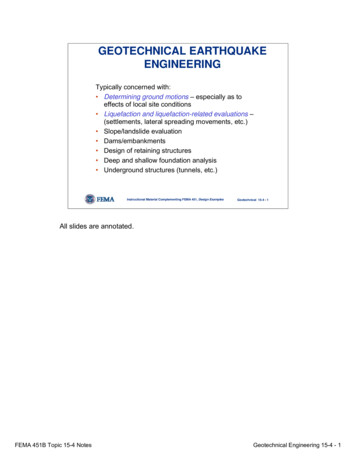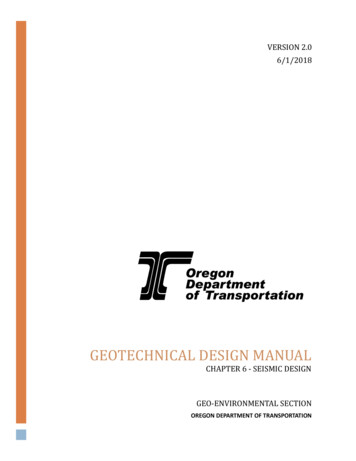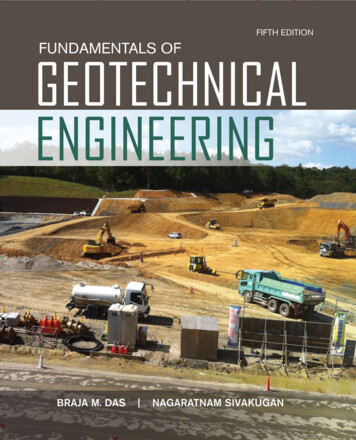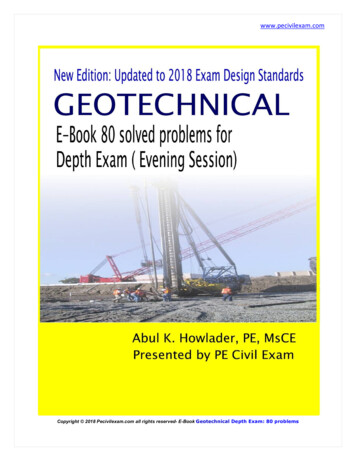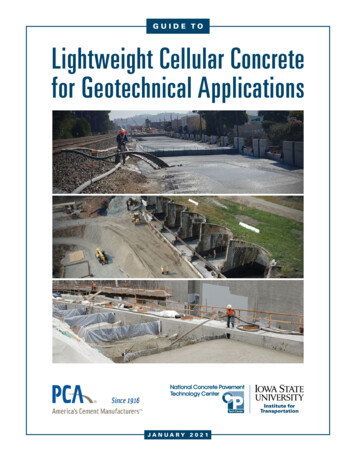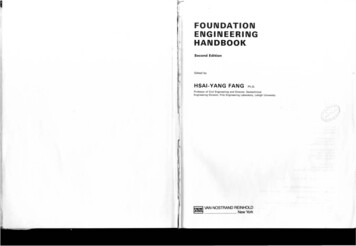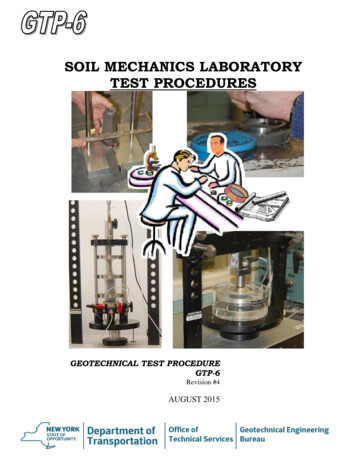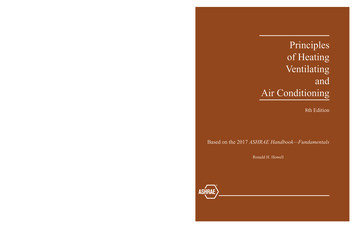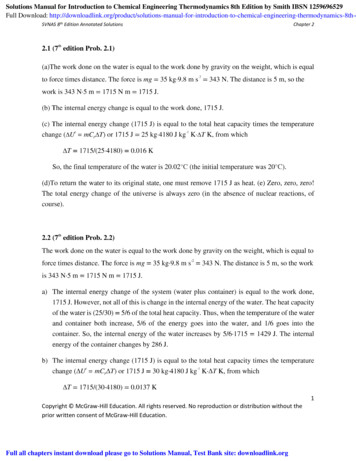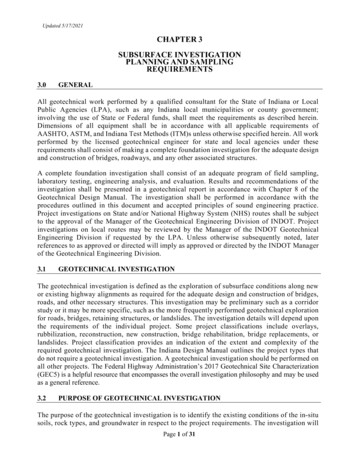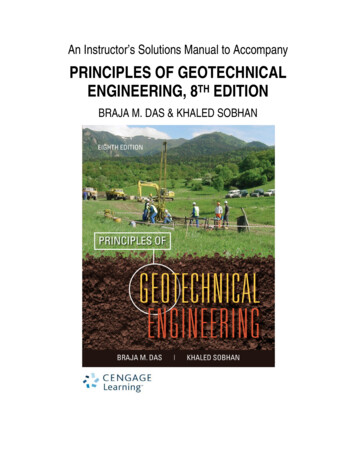
Transcription
An Instructor’s Solutions Manual to AccompanyPRINCIPLES OF GEOTECHNICALENGINEERING, 8TH EDITIONBRAJA M. DAS & KHALED SOBHAN
ISBN-13: 978-1-133-11089-7ISBN-10: 1-133-11089-4 2014, 2010 Cengage LearningALL RIGHTS RESERVED. No part of this work covered by thecopyright herein may be reproduced, transmitted, stored, orused in any form or by any means graphic, electronic, ormechanical, including but not limited to photocopying,recording, scanning, digitizing, taping, Web distribution,information networks, or information storage and retrievalsystems, except as permitted under Section 107 or 108 of the1976 United States Copyright Act, without the prior writtenpermission of the publisher except as may be permitted by thelicense terms below.For product information and technology assistance, contact us atCengage Learning Academic Resource Center,1-800-423-0563.For permission to use material from this text or product, submitall requests online at www.cengage.com/permissions.Further permissions questions can be emailed topermissionrequest@cengage.com.Cengage Learning200 First Stamford Place, Suite 400Stamford, CT 06902USACengage Learning is a leading provider of customizedlearning solutions with office locations around the globe,including Singapore, the United Kingdom, Australia,Mexico, Brazil, and Japan. Locate your local office at:international.cengage.com/region.Cengage Learning products are represented inCanada by Nelson Education, Ltd.For your course and learning solutions, visitwww.cengage.com/engineering.Purchase any of our products at your local collegestore or at our preferred online storewww.cengagebrain.com.NOTE: UNDER NO CIRCUMSTANCES MAY THIS MATERIAL OR ANY PORTION THEREOF BE SOLD, LICENSED, AUCTIONED,OR OTHERWISE REDISTRIBUTED EXCEPT AS MAY BE PERMITTED BY THE LICENSE TERMS HEREIN.READ IMPORTANT LICENSE INFORMATIONDear Professor or Other Supplement Recipient:Cengage Learning has provided you with this product (the“Supplement”) for your review and, to the extent that you adoptthe associated textbook for use in connection with your course(the “Course”), you and your students who purchase thetextbook may use the Supplement as described below.Cengage Learning has established these use limitations inresponse to concerns raised by authors, professors, and otherusers regarding the pedagogical problems stemming fromunlimited distribution of Supplements.Cengage Learning hereby grants you a nontransferable licenseto use the Supplement in connection with the Course, subject tothe following conditions. The Supplement is for your personal,noncommercial use only and may not be reproduced, postedelectronically or distributed, except that portions of theSupplement may be provided to your students IN PRINT FORMONLY in connection with your instruction of the Course, so longas such students are advised that they may not copy ordistribute any portion of the Supplement to any third party. Testbanks and other testing materials may be made available in theclassroom and collected at the end of each class session, orPrinted in the United States of America1 2 3 4 5 6 7 16 15 14 13 12posted electronically as described herein. Any material postedelectronically must be through a password-protected site, with allcopy and download functionality disabled, and accessible solely byyour students who have purchased the associated textbook for theCourse. You may not sell, license, auction, or otherwise redistributethe Supplement in any form. We ask that you take reasonablesteps to protect the Supplement from unauthorized use,reproduction, or distribution. Your use of the Supplement indicatesyour acceptance of the conditions set forth in this Agreement. If youdo not accept these conditions, you must return the Supplementunused within 30 days of receipt.All rights (including without limitation, copyrights, patents, and tradesecrets) in the Supplement are and will remain the sole andexclusive property of Cengage Learning and/or its licensors. TheSupplement is furnished by Cengage Learning on an “as is” basiswithout any warranties, express or implied. This Agreement will begoverned by and construed pursuant to the laws of the State ofNew York, without regard to such State’s conflict of law rules.Thank you for your assistance in helping to safeguard the integrityof the content contained in this Supplement. We trust you find theSupplement a useful teaching tool.
INSTRUCTOR’S SOLUTIONS MANUALTO ACCOMPANYPRINCIPLES OFGEOTECHNICALENGINEERINGEighth Edition, SIBRAJA M. DASKHALED SOBHAN
ContentsChapterPage2 . 13 . 114 . 195 . 256 . 317 . 418 . 519 . 5710 . 6911 . 8312 . 9913 . 10914 . 12115 . 12716 . 14117 . 153
Chapter 22.1Cu 0.212D302D60 0.42 0.656 0.66 2.625 2.63 ; Cc ( D60 )( D10 ) (0.42)(0.16)D10 0.162.2Cu 0.412D302D60 0.81 0.768 0.77 3.0 ; Cc ( D60 )( D10 ) (0.81)(0.27)D10 0.272.3a.Sieveno.410204060100200PanMass of soil retainedon each sieve (g)284248128221864024 617 gPercent retainedon each er95.4688.6580.8860.1324.3110.373.890.001 2014 Cengage Learning. All Rights Reserved. May not be scanned, copied or duplicated, or posted to a publicly accessible website, in whole or in part.
b. D10 0.16 mm; D30 0.29 mm; D60 0.45 mm2.4c. Cu D60 0.45 2.812 2.81D10 0.16d. Cc D3020.292 1.168 1.17( D60 )( D10 ) (0.45)(0.16)a.Sieveno.4610204060100200PanMass of soil retainedon each sieve (g)03048.7127.396.876.655.243.422 500 gPercent retainedon each Finer100.0094.084.2658.8039.4424.1213.084.400.00b. D10 0.13 mm; D30 0.3 mm; D60 0.9 mm2 2014 Cengage Learning. All Rights Reserved. May not be scanned, copied or duplicated, or posted to a publicly accessible website, in whole or in part.
c. Cu 0 .9D60 6.923 6.92D10 0.130.32D302d. Cc 0.769 0.77( D60 )( D10 ) (0.9)(0.13)2.5a.Sieveno.41020406080100200PanMass of soil retainedon each sieve (g)04060891401222105612 729 gPercent retainedon each . D10 0.17 mm; D30 0.18 mm; D60 0.28 mmc. Cu D60 0.28 1.647 1.65D10 0.173 2014 Cengage Learning. All Rights Reserved. May not be scanned, copied or duplicated, or posted to a publicly accessible website, in whole or in part.
D3020.18 2d. Cc 0.68( D60 )( D10 ) (0.28)(0.17)2.6a.Sieveno.4610204060100200PanMass of soil retainedon each sieve (g)0009.1249.4179.822.715.523.5 500 gPercent retainedon each 100.00100.00100.0098.1848.312.347.84.70.00b. D10 0.21 mm; D30 0.39 mm; D60 0.45 mmc. Cu D60 0.45 2.142 2.14D10 0.21d. Cc 0.39 2D302 1.609 1.61( D60 )( D10 ) (0.45)(0.21)4 2014 Cengage Learning. All Rights Reserved. May not be scanned, copied or duplicated, or posted to a publicly accessible website, in whole or in part.
2.7a.b. Percent passing 2 mm 100GRAVEL: 100 – 100 0%SAND: 100 – 73 27%SILT: 73 – 9 64%CLAY: 9 – 0 9%Percent passing 0.06 mm 73Percent passing 0.002 mm 9c. Percent passing 2 mm 100Percent passing 0.05 mm 68Percent passing 0.002 mm 9GRAVEL: 100 – 100 0%SAND: 100 – 68 32%SILT: 68 – 9 59%CLAY: 9 – 0 9%d. Percent passing 2 mm 100Percent passing 0.075 mm 80Percent passing 0.002 mm 9GRAVEL: 100 – 100 0%SAND: 100 – 80 20%SILT: 80 – 9 71%CLAY: 9 – 0 9%5 2014 Cengage Learning. All Rights Reserved. May not be scanned, copied or duplicated, or posted to a publicly accessible website, in whole or in part.
2.8a.b. Percent passing 2 mm 100Percent passing 0.06 mm 30Percent passing 0.002 mm 5GRAVEL: 100 – 100 0%SAND: 100 – 30 70%SILT: 70 – 5 65%CLAY: 5 – 0 5%c. Percent passing 2 mm 100Percent passing 0.05 mm 28Percent passing 0.002 mm 5GRAVEL: 100 – 100 0%SAND: 100 – 28 72%SILT: 72 – 5 67%CLAY: 5 – 0 5%d. Percent passing 2 mm 100Percent passing 0.075 mm 34Percent passing 0.002 mm 5GRAVEL: 100 – 100 0%SAND: 100 – 34 66%SILT: 66 – 5 61%CLAY: 5 – 0 5%6 2014 Cengage Learning. All Rights Reserved. May not be scanned, copied or duplicated, or posted to a publicly accessible website, in whole or in part.
2.9a.b. Percent passing 2 mm 100Percent passing 0.06 mm 84Percent passing 0.002 mm 28GRAVEL: 100 – 100 0%SAND: 100 – 84 16%SILT: 84 – 28 56%CLAY: 28 – 0 28%c. Percent passing 2 mm 100Percent passing 0.05 mm 83Percent passing 0.002 mm 28GRAVEL: 100 – 100 0%SAND: 100 – 83 17%SILT: 83 – 28 55%CLAY: 28 – 0 28%d. Percent passing 2 mm 100Percent passing 0.075 mm 90Percent passing 0.002 mm 28GRAVEL: 100 – 100 0%SAND: 100 – 90 10%SILT: 90 – 28 62%CLAY: 28 – 0 28%7 2014 Cengage Learning. All Rights Reserved. May not be scanned, copied or duplicated, or posted to a publicly accessible website, in whole or in part.
2.102.11a.b. Percent passing 2 mm 100Percent passing 0.06 mm 65Percent passing 0.002 mm 35GRAVEL: 100 – 100 0%SAND: 100 – 65 35%SILT: 65 – 35 30%CLAY: 35 – 0 35%c. Percent passing 2 mm 100Percent passing 0.05 mm 62Percent passing 0.002 mm 35GRAVEL: 100 – 100 0%SAND: 100 – 62 38%SILT: 62 – 35 27%CLAY: 35 – 0 35%d. Percent passing 2 mm 100Percent passing 0.075 mm 70Percent passing 0.002 mm 35GRAVEL: 100 – 100 0%SAND: 100 – 70 30%SILT: 70 – 35 35%CLAY: 35 – 0 35%Gs 2.7; temperature 24 ; time 60 min; L 9.2 cmEq. (2.5): D (mm) KL (cm)t (min)8 2014 Cengage Learning. All Rights Reserved. May not be scanned, copied or duplicated, or posted to a publicly accessible website, in whole or in part.
From Table 2.6 for Gs 2.7 and temperature 24 , K 0.01282D 0.012822.129.2 0.005 mm60Gs 2.75; temperature 23 C; time 100 min; L 12.8 cmEq. (2.5): D (mm) KL (cm)t (min)From Table 2.6 for Gs 2.75 and temperature 23 , K 0.01279D 0.0127912.8 0.0046 mm100CRITICAL THINKING PROBLEM2.C.1 a. Soil A:D30252D60 11 3.78 18.33 ; Cc Cu D10 0.6( D60 )( D10 ) (11)(0.6)D3022.12D607 3.15 35 ; Cc ( D60 )( D10 ) (7)(0.2)D10 0.2Soil B:Cu Soil C:D30212D604 .5 1.48 30 ; Cc Cu D10 0.15( D60 )( D10 ) (4.5)(0.15)b. Soil A is coarser than Soil C. A higher percentage of soil C is finer than anygiven size compared to Soil A. For example, about 15% is finer than 1 mmfor Soil A, whereas almost 30% is finer than 1 mm in case of soil C.c. Particle segregation may take place in aggregate stockpiles such that there is aseparation of coarser and finer particles. This makes representative samplingdifficult. Therefore Soils A, B, and C demonstrate quite different particle sizedistribution.9 2014 Cengage Learning. All Rights Reserved. May not be scanned, copied or duplicated, or posted to a publicly accessible website, in whole or in part.
d. Soil A:Percent passing 4.75 mm 29Percent passing 0.075 mm 1GRAVEL: 100 – 29 71%SAND: 29 – 1 28%FINES: 1 – 0 1%Soil B:Percent passing 4.75 mm 45Percent passing 0.075 mm 2GRAVEL: 100 – 45 55%SAND: 45 – 2 43%FINES: 2 – 0 2%Soil C:Percent passing 4.75 mm 53Percent passing 0.075 mm 3GRAVEL: 100 – 53 47%SAND: 47 – 3 44%FINES: 3 – 0 3%10 2014 Cengage Learning. All Rights Reserved. May not be scanned, copied or duplicated, or posted to a publicly accessible website, in whole or in part.
Chapter 33.1γ sat 3.2γ sat 3.3 1 wsat (Gs e)γ w Gsγ w e γ weγw γ w n γw n 1 e1 e 1 e (1 e) wsatwsat (Gs e)γ w1 e Gs γ w eγ w e γd γ w1 e 1 e 1 e Rearranging,γ sat (1 e) γ d (1 e) e γ wTherefore, e γ sat γ dγ d γ sat γ w 1 wsat 1 wsat G s γ w 1 e 1 e γ sat e γ w (1 wsat )n γ w wsat wsatRearranging, wsat (γ sat n γ w ) n γ wTherefore, wsat 3.4a. γ W 12.5 125 lb/ft3V0.1b. γ d c. e d. n nγwγ sat n γ wγ1 wGs γ wγd 125 109.64 lb/ft31 0.14 1 (2.71)(62.4) 1 0.54109.64e0.54 0.351 e 1 0.5411 2014 Cengage Learning. All Rights Reserved. May not be scanned, copied or duplicated, or posted to a publicly accessible website, in whole or in part.
e. S ( w)(Gs ) (0.14)(2.71) 0.702 70.2%e0.54f. Volume of water 3.5γw (125 109.64)(0.1) 0.024 ft362.4(1 0.098)( 2.69)(9.81) 1 w a. γ ; e 0.51 Gs γ w ; 19.2 1 e 1 e Gs γ w (2.69)(9.81) 17.48 kN/m31 e1 0.51b. γ d c. S 3.6(γ γ d )Va.( w)(Gs ) (0.098)(2.69) 0.517 51.7%e0.51(Gs Se)γ w (2.69)(9.81) (0.9)(0.51)(9.81) 20.45 kN/m31 e1 0.51γ Water to be added 20.45 – 19.2 1.25 kN/m3b. γ sat (Gs e)γ w (2.69 0.51)(9.81) 20.78 kN/m31 e1 0.51Water to be added 20.78 – 19.2 1.58 kN/m33.7πW9.56 1 (2.8) 2 (22) 3 0.078 ft3; γ 122.56 lb/ft34V 0.078 12 a. V b. w W Ws 9.56 8.51 0.1233 12.33%8.51Wsc. γ d Ws8.51 109.1 lb/ft3V0.07812 2014 Cengage Learning. All Rights Reserved. May not be scanned, copied or duplicated, or posted to a publicly accessible website, in whole or in part.
d. e e. S 3.8a. γ b. e Gs γ wγd(1 w)Gs γ w (1 w)Gs γ w(1 0.26)(Gs )(62.4); Gs 2.72 ; 108 (0.26)(Gs )w Gs1 e1 1 0.72SwGs (0.26)(2.72) 0.980.72Sa. γ d b. e 3.10(2.69)(62.4) 1 0.54109.1wGs (0.1233)(2.69) 0.614 61.4%e0.54c. γ sat 3.9 1 (Gs e)γ w (2.72 0.98)(62.4) 116.6 lb/ft31 e1 0.98γ1 wGs γ wγd 20.6 17.67 kN/m31 0.166 1 (2.74)(9.81) 1 0.5217.67c. n e0.52 0.341 e 1 0.52d. S wGs (0.166)(2.74) 0.874 87.4%e0.52a. γ (Gs Se)γ w (2.74)(9.81) (0.9)(0.52)(9.81) 20.7 kN/m31 e1 0.52Water to be added 20.7 – 20.6 0.1 kN/m3b. γ sat (Gs e)γ w (2.74 0.52)(9.81) 21.04 kN/m31 e1 0.5213 2014 Cengage Learning. All Rights Reserved. May not be scanned, copied or duplicated, or posted to a publicly accessible website, in whole or in part.
Water to be added 21.04 – 20.6 0.44 kN/m33.11ρa. ρ d b.e 1 wGs ρ wρd 1750 1422.76 kg/m31 0.23 1 e0.92(2.73)(1000) 1 0.92 ; n 0.481422.761 e 1 0.92wGs (0.23)(2.73) 0.682 68.2%e0.92c. S d. ρ sat (Gs e) ρ w (2.73 0.92)(1000) 2967 kg/m31 e1 0.23Water to be added 2967 – 1750 1217 kg/m33.12a. γ d γ1 wGs γ wb. e γd 30.75 112 lb/ft30.25(1 0.098) 1 (2.66)(62.4) 1 0.48112 30.75 112 (0.25) (γ γ d )V 0.25 c. Volume of water 0.044 ft3 γw62.43.13a. e n0.3 0.431 n 1 0.3b. ρ d 3.14e Gs γ wγdρ (1 e) 1800(1 0.43)Gs ρ w 2.57; Gs d1000ρw1 e 1 (2.69)(62.4) 1 0.59810514 2014 Cengage Learning. All Rights Reserved. May not be scanned, copied or duplicated, or posted to a publicly accessible website, in whole or in part.
S 3.15wGs (0.17)(2.69) 0.764 76.4%e0.598a. γ (1 w)Gs γ w (1 w)Gs γ w (1 0.182)(2.67)(62.4) 122.5 lb/ft3wGs(0.182)(2.67)1 e1 1 0.8Sb. γ d γ1 w 122.5 103.61 0.182Volume of water 3.16a. γ (γ γ d )Vγw (122.5 103.6)(1) 0.302 ft3/ft3 of soil62.4(G s Se)γ w(G 0.55e)(62.4); 106 s1 e1 eGs 1.148e 1.698114 (i)(Gs 0.822e)(62.4)1 e(ii)From (i) and (ii): Gs 2.73b. Using Gs 2.73 in Equation (i), we get e 0.93.173.18a.Dr emax e0.75 e; 0.65 ; e 0.6emax emin0.75 0.52b.γd Gs γ w (2.67)(9.81) 16.37 kN/m31 e1 0.6Dr emax e0.72 e; 0.82 ; e 0.51emax emin0.72 0.4615 2014 Cengage Learning. All Rights Reserved. May not be scanned, copied or duplicated, or posted to a publicly accessible website, in whole or in part.
γ 3.19(1 w)Gs γ w (1 0.11)(2.68)(9.81) 19.32 kN/m31 e1 0.51γd γ1 w 115 106.48 lb/ft31 0.08 1 1 1 1 92 106.48 γγd (min) d Dr 0.918 91.8% 1 1 1 1 92 108 γγ d (min) d (max) CRITICAL THINKING PROBLEMS3.C.1 a.e VVv; e1 1 1VsVs1 0.92 V1; V1 1.92VsVs1 0.65 V2; V2 1.65VsVsΔV V1 V2 1.92 1.65 0.14 14% (decrease)1.92VV1b. γ d (1) γ d ( 2) Gs γ wGγGγ s w s w1 e1 1 0.92 1.92Gs γ w1.6516 2014 Cengage Learning. All Rights Reserved. May not be scanned, copied or duplicated, or posted to a publicly accessible website, in whole or in part.
11γ d ( 2) γ d (1) 1.65 1.92 0.163 16.3% (increase)1γ d (1)Δγ dγ d (1)1.92c. S1 wGs wGswGs ; S2 0.92e10.6511 ΔS S2 S1 0.65 0.92 0.415 41.5% (increase)1S1S10.923.C.2 a. Dr emax eemax emine1 emax Dr (emax emin ) 0.92 0.47(0.92 0.53) 0.736γd Gs γ w (2.65)(9.81) 14.97 kN/m3 (before compaction)1 e11 0.736e2 emax Dr (emax emin ) 0.92 0.8(0.92 0.53) 0.608γd b.(2.65)(9.81) 16.17 kN/m3 (after compaction)1 0.608ΔHΔe0.736 0.608 0.074 ; ΔH 0.074H (0.074)(2) 0.148 mH 1 e11 0.736Final Height 2 – 0.148 1.852 m17 2014 Cengage Learning. All Rights Reserved. May not be scanned, copied or duplicated, or posted to a publicly accessible website, in whole or in part.
18 2014 Cengage Learning. All Rights Reserved. May not be scanned, copied or duplicated, or posted to a publicly accessible website, in whole or in part.
Chapter 44.1a. Refer to the plotof w versus N.LL 29.0b.PI LL – PL 29.0 – 13.4 15.6w PL32 13.4 1.19LL PL15.64.2LI 4.3a. From the plot,LL 23.6.b.PI LL – PL 23.6 – 19.1 4.519 2014 Cengage Learning. All Rights Reserved. May not be scanned, copied or duplicated, or posted to a publicly accessible website, in whole or in part.
w PL 21 19.1 0.422LL PL4.54.4LI 4.5 M M2 V Vf (100) iSL 1 M2 M2 ( ρ w )(100) 34 24 20.2 14.3 (100) (1)(100) 17.0824 24 SR 4.6M224 1.68Vf ρ w (14.3)(1) M M2 V Vf (100) iSL 1 M2 M2 ( ρ w )(100) 44.6 32.8 16.2 10.8 (100) (1)(100) 19.5132.8 32.8 SR 32.8M2 3.03Vf ρw (10.8)(1)CRITICAL THINKING PROBLEMS4.C.1 a. From Eq. (4.26): A PI(% of clay - size fraction, by weight)The computed PI values are provided in the table on the following page.20 2014 Cengage Learning. All Rights Reserved. May not be scanned, copied or duplicated, or posted to a publicly accessible website, in whole or in part.
SoilBeauharnoisDetroit IHortenGosportMexico CityShellhavenSt. Thuribe% clay( 0.002 mmin 5311.881.36.92.413.08.74.80.3b. From Table 4.2:BeauharnoisA 0.52; PI 41.08; Mineral: IlliteDetroit IA 0.36; PI 12.96; Mineral: KaoliniteHortenA 0.42; PI 16.8; Mineral: KaoliniteGosportA 0.89; PI 48.95; Mineral: IlliteMexico CityA 4.5; PI 405; Mineral: MontmorilloniteShellhavenA 1.33; PI 54.53; Mineral: IlliteSt. ThuribeA 0.33; PI 11.88; Mineral: Kaolinitec. Sensitivity, S t τ f undisturbedτ f remoldedτf-remolded is calculated using the above equation and listed in the table (Part a).21 2014 Cengage Learning. All Rights Reserved. May not be scanned, copied or duplicated, or posted to a publicly accessible website, in whole or in part.
d. The plots are shown below.50Shear Strength ion: The shear strength of clay comes from two components: thecohesion, which is the cementing force between particles, and the frictionalresistance, which is mainly due to the movement of one particle over another. Thegreater the activity of clay, the greater is the contribution of cohesion to shearstrength. Although no reliable correlation can be developed from the above plots,both the undisturbed and remolded shear strengths certainly show increasingtrends as the activity increases.4.C.2 a. The liquidity index is given by: LI w PLLL PLThe range of liquidity index corresponding to the range in natural watercontent is calculated and listed in the table.Soil1234567% clay( 0.002 mmin 0.750.34-0.5722 2014 Cengage Learning. All Rights Reserved. May not be scanned, copied or duplicated, or posted to a publicly accessible website, in whole or in part.
b. Soils 1 and 4: Since LI range is greater than 1.0, the water content is greaterthan the liquid limit. From Figure 4.1, the soil behaves like a viscous fluidwith practically no shearing resistance.Soil 2: At a water content of 18%, the LI 0, and the soil behaves like abrittle solid with high shear resistance. At water content of 36%, the soil is ina plastic state (0 LI 1) showing moderate shearing resistance and a ductilebehavior.Soils 3, 6, and 7: Since 0 LI 1, the water content is less than the liquidlimit. From Figure 4.1, the soil is in the plastic state showing moderateshearing resistance and a ductile behavior.Soil 5: At a water content of 441%, the soil is in the plastic state (0 LI 1)with moderate shear resistance. At water content of 600%, the LI 1, and thesoil becomes a viscous fluid with practically no shearing resistance.23 2014 Cengage Learning. All Rights Reserved. May not be scanned, copied or duplicated, or posted to a publicly accessible website, in whole or in part.
24 2014 Cengage Learning. All Rights Reserved. May not be scanned, copied or duplicated, or posted to a publicly accessible website, in whole or in part.
Chapter 55.1Refer to Figure 5.1.SoilABCDE5.2ClassificationClaySandy clayLoamSandy clay and sandy clay loam (borderline)Sandy loamSOIL A:From Table 5.1, the soil is A-2-4. The GI for A-2-4 is zero.Classification: A-2-4(0).SOIL B:From Table 5.1, the soil is A-3. GI 0. Classification: A-3(0).SOIL C:From Table 5.1, the soil is A-2-6. Equation 5.2:GI 0.01( F200 15)( PI 10) 0.01(12 15)(13 10) 0.09 0Classification: A-2-6(0)SOIL D:From Table 5.1, the soil is A-2-7. Equation 5.2:GI 0.01( F200 15)( PI 10) 0.01(30 15)(18 10) 1.2 1Classification: A-2-7(1)5.3SOIL E:From Table 5.1, the soil is A-1-b. GI 0. Classification: A-1-b(0).SOIL A:From Table 5.1, the soil is A-7-5. Note: PI 21 LL – 30 22Eq. (5.1):GI ( F200 35)[0.2 0.005( LL 40)] 0.01( F200 15)( PI 10)GI (72 35)[0.2 0.005(52 40)] 0.01(72 15)(21 10) 15.89 16Classification: A-7-5(16).SOIL B:From Table 5.1, the soil is A-6. Eq. (5.1):GI ( F200 35)[0.2 0.005( LL 40)] 0.01( F200 15)( PI 10)GI (58 35)[0.2 0.005(38 40)] 0.01(58 15)(12 10) 5.23 5Classification: A-6(5)25 2014 Cengage Learning. All Rights Reserved. May not be scanned, copied or duplicated, or posted to a publicly accessible website, in whole or in part.
SOIL C:From Table 5.1, the soil is A-7-6. Note: PI 14 LL – 30 11Eq. (5.1):GI ( F200 35)[0.2 0.005( LL 40)] 0.01( F200 15)( PI 10)GI (64 35)[0.2 0.005(41 40)] 0.01(64 15)(14 10) 7.9 8Classification: A-7-6(8)SOIL D:From Table 5.1, the soil is A-6. Eq. (5.1):GI ( F200 35)[0.2 0.005( LL 40)] 0.01( F200 15)( PI 10)GI (82 35)[0.2 0.005(32 40)] 0.01(82 15)(12 10) 8.86 9Classification: A-6(9)SOIL E:From Table 5.1, the soil is A-6. Eq. (5.1):GI ( F200 35)[0.2 0.005( LL 40)] 0.01( F200 15)( PI 10)GI (48 35)[0.2 0.005(30 40)] 0.01(48 15)(11 10) 2.28 2Classification: A-6(2)5.4SOIL 1:Fine fraction % passing No. 200 sieve 30%Coarse fraction 100 -30 70%Gravel fraction 100 – 70 30%Sand fraction 70 – 30 40%More than 50% of coarse fraction passing No. 4 sieve, so sandy soil.Table 5.2 and Figure 5.3: SCFigure 5.4: More than 15% gravel. Clayey sand with gravel.SOIL 2:Coarse fraction 200 – 20 80%Gravel fraction 100 – 48 52%Sand fraction 80 – 52 28%Table 5.2 and Figure 5.3: GCFigure 5.4: Greater than 15% sand. Clayey gravel with sandSOIL 3:Coarse fraction 100 – 30 30%Gravel fraction 100 – 95 5%Sand fraction 95 – 70 25%Table 5.2: fine-grained soil; LL 52; PI 28.Table 5.2 and Figure 5.3: CHFigure 5.5: 30% plus 200, % sand % gravel, 15% gravel,so sandy fat clay26 2014 Cengage Learning. All Rights Reserved. May not be scanned, copied or duplicated, or posted to a publicly accessible website, in whole or in part.
SOIL 4:Coarse fraction 100 – 82 18%Gravel fraction 100 – 100 0%Sand fraction 18 – 0 18%Table 5.2: fine-grained soil; LL 30; PI 19.Table 5.2 and Figure 5.3: CLFigure 5.5: lean clay with sandSOIL 5:Coarse fraction 100 – 74 26%Gravel fraction 100 – 100 0%Sand fraction 26 – 0 26%Table 5.2: fine-grained soil; LL 35; PI 21.Table 5.2 and Figure 5.3: CLFigure 5.5: lean clay with sandSOIL 6:Coarse fraction 100 – 26 74%Gravel fraction 100 – 87 13%Sand fraction 74 – 13 61%Table 5.2: coarse-grained soil; LL 38; PI 18.Table 5.2 and Figure 5.3: SCFigure 5.4: 15% gravel; clayey sandSOIL 7:Coarse fraction 100 – 78 22%Gravel fraction 100 – 88 12%Sand fraction 22 – 12 10%Table 5.2: fine-grained soil; LL 52; PI 28.Table 5.2 and Figure 5.3: CHFigure 5.5: 30% plus 200, % sand % gravel; fat clay with gravelSOIL 8:Coarse fraction 100 – 57 43%Gravel fraction 100 – 99 1%Sand fraction 43 – 1 42%Table 5.2: fine-grained soil; LL 54; PI 26.Table 5.2 and Figure 5.3: CHFigure 5.5: 30% plus 200, % sand % gravel; sandy fat claySOIL 9:Coarse fraction 100 – 11 89%Gravel fraction 100 – 71 29%Sand fraction 89 – 29 70%LL 32; PI 16; Cu 4.8; Cc 2.9. Table 5.2 and Figure 5.3: SP-SCFigure 5.4: poorly graded sand with clay and gravel27 2014 Cengage Learning. All Rights Reserved. May not be scanned, copied or duplicated, or posted to a publicly accessible website, in whole or in part.
SOIL 10: Coarse fraction 100 – 2 98%Gravel fraction 100 – 100 0%Sand fraction 98 – 0 98%Cu 7.2; Cc 2.2. Table 5.2: SWFigure 5.4: 15% gravel; well graded sandSOIL 11: Coarse fraction 100 – 65 35%Gravel fraction 100 – 89 11%Sand fraction 35 – 11 24%Table 5.2: fine-grained soil; LL 44; PI 21.Table 5.2 and Figure 5.3: CLFigure 5.5: sandy lean claySOIL 12: Coarse fraction 100 – 8 92%Gravel fraction 100 – 90 10%Sand fraction 92 – 10 82%LL 39; PI 31; Cu 3.9; Cc 2.1. Table 5.2 and Figure 5.3: SP-SCFigure 5.4: poorly graded sand with clay5.5a. 13% passing No. 200 sieve; 38% passing No. 40 sieve; 90% passing No. 10sieve. PI 23 – 19 4. Referring to Table 5.1, the soil is A-1-b. GI 0.So the soil is A-1-b(0).b. Coarse fraction 100 – 13 87%Gravel fraction 100 – 100 0%Sand fraction 87 – 0 87%LL 23; PI 4. From Table 5.2 and Figure 5.3, the group symbol is SC.From Figure 5.4, the group name is clayey sand.CRITICAL THINKING PROBLEM5.C.1 1. Stratum 218% passing No. 200 sieve; PI 5. From Table 5.1, the soil is A-1-b.GI 0; Soil classification: A-1-b(0)Stratum 38% passing No. 200 sieve; NP. From Table 5.1, the soil is A-3.GI 0; Soil classification: A-3(0)28 2014 Cengage Learning. All Rights Reserved. May not be scanned, copied or duplicated, or posted to a publicly accessible website, in whole or in part.
Stratum 467% passing No. 200 sieve; LL 52; PI 10. From Table 5.1, the soil is A-5.GI ( F200 35)[0.2 0.005( LL 40)] 0.01( F200 15)( PI 10)GI (67 35)[0.2 0.005(52 40)] 0.01(67 15)(10 10) 8.3 8Soil classification: A-5(8)Stratum 552% passing No. 200 sieve; LL 36; PI 9. From Table 5.1, the soil is A-4.GI (52 35)[0.2 0.005(36 40)] 0.01(52 15)(9 10) 2.69 3Soil classification: A-4(3)2. Stratum 2Coarse fraction: 100 – 18 82%; Table 5.2: coarse-grained soil. From Table5.4, most probable soil classification (corresponding to A-1-b): SW, SP, GM,SM. Since it is a fine sand, and since Cc is not between 1 and 3, it is a poorlygraded sand. Classification: SPStratum 3Coarse fraction: 100 – 8 92%; Table 5.2: coarse-grained soil. From Table5.4, most probable soil classification (corresponding to A-3): SP. Since it is anon-plastic fine sand, classification: SPStratum 4Coarse fraction: 100 – 67 23%
the associated textbook for use in connection with your course (the “Course”), you and your students who purchase the textbook may use the Supplement as described below. . GEOTECHNICAL ENGINEERING Eighth Editi
